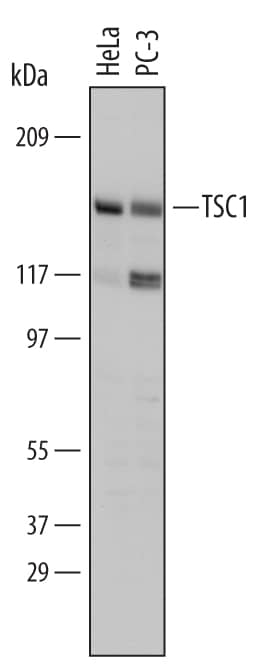Human TSC1 Antibody Summary
Asp156-Thr300
Accession # Q92574
Customers also Viewed
Applications
Please Note: Optimal dilutions should be determined by each laboratory for each application. General Protocols are available in the Technical Information section on our website.
Scientific Data
 View Larger
View Larger
Detection of Human TSC1 by Western Blot. Western blot shows lysates of HeLa human cervical epithelial carcinoma cell line and PC-3 human prostate cancer cell line. PVDF Membrane was probed with 1 µg/mL of Human TSC1 Monoclonal Antibody (Catalog # MAB4379) followed by HRP-conjugated Anti-Mouse IgG Secondary Antibody (Catalog # HAF007). A specific band was detected for TSC1 at approximately 130 kDa (as indicated). This experiment was conducted under reducing conditions and using Immunoblot Buffer Group 1.
 View Larger
View Larger
Detection of TSC1 in Jurkat Human Cell Line by Flow Cytometry. Jurkat human acute T cell leukemia cell line was stained with Human TSC1 Monoclonal Antibody (Catalog # MAB4379, filled histogram) or isotype control antibody (Catalog # MAB0041, open histogram), followed by Phycoerythrin-conjugated Anti-Mouse IgG F(ab')2Secondary Antibody (Catalog # F0102B). To facilitate intracellular staining, cells were fixed with PFA and permeabilized with saponin.
Preparation and Storage
- 12 months from date of receipt, -20 to -70 °C as supplied.
- 1 month, 2 to 8 °C under sterile conditions after reconstitution.
- 6 months, -20 to -70 °C under sterile conditions after reconstitution.
Background: TSC1
TSC1 (Tuberous sclerosis 1), or hamartin, is a tumor suppressor which interacts with tumor suppressor TSC2 (tuberin) to form a cytoplasmic heterodimer. Mutations in either hamartin or tuberin are responsible for tuberous sclerosis (TSC), an autosomal dominant disease characterized by renal dysfunction, seizures, developmental delays, benign hamartomas and low grade neoplasms predominantly affecting the CNS, kidney, lung, skin, and heart. The TSC1/TSC2 complex suppresses cell growth by inhibiting mTOR, with TSC1 acting to inhibit the ubiquitination of TSC2, leading to increased cellular levels of TSC2 and thus enhancing its catalytic activity as a GTPase-activating protein for Rheb. TSC1 and TSC2 are also involved in the G2/M transition of the cell cycle through their interactions with CDK1 and cyclin B1. TSC1 has also been shown to interact with F-actin and ERM (Ezrin-Radixin-Moesin) proteins, implying a role in the modulation of cell adhesion and morphology.
Product Datasheets
Citation for Human TSC1 Antibody
R&D Systems personnel manually curate a database that contains references using R&D Systems products. The data collected includes not only links to publications in PubMed, but also provides information about sample types, species, and experimental conditions.
1 Citation: Showing 1 - 1
-
Death-associated protein kinase 1 promotes growth of p53-mutant cancers.
Authors: Zhao J, Zhao D, Poage G, Mazumdar A, Zhang Y, Hill J, Hartman Z, Savage M, Mills G, Brown P
J Clin Invest, 2015-06-15;125(7):2707-20.
Species: Human
Sample Types: Cell Lysates
Applications: Immunoprecipitation
FAQs
No product specific FAQs exist for this product, however you may
View all Antibody FAQsIsotype Controls
Reconstitution Buffers
Secondary Antibodies
Reviews for Human TSC1 Antibody
There are currently no reviews for this product. Be the first to review Human TSC1 Antibody and earn rewards!
Have you used Human TSC1 Antibody?
Submit a review and receive an Amazon gift card.
$25/€18/£15/$25CAN/¥75 Yuan/¥2500 Yen for a review with an image
$10/€7/£6/$10 CAD/¥70 Yuan/¥1110 Yen for a review without an image




